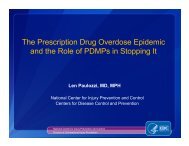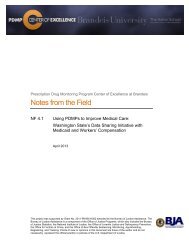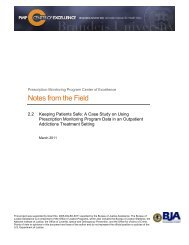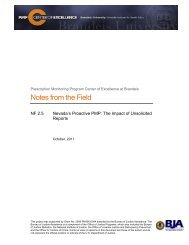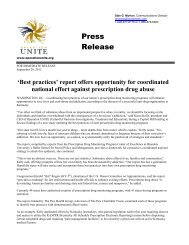Prescription Drug Monitoring Programs - PDMP Center of Excellence
Prescription Drug Monitoring Programs - PDMP Center of Excellence
Prescription Drug Monitoring Programs - PDMP Center of Excellence
You also want an ePaper? Increase the reach of your titles
YUMPU automatically turns print PDFs into web optimized ePapers that Google loves.
<strong>Prescription</strong> <strong>Drug</strong> <strong>Monitoring</strong> <strong>Programs</strong>: An Assessment <strong>of</strong> the Evidence for Best Practices 4possible doctor shoppers—that is, individuals receiving multiple simultaneous prescriptions <strong>of</strong> commonlyabused drugs. This resulted in a rapid demand for reports upon request (<strong>Prescription</strong> <strong>Drug</strong> <strong>Monitoring</strong>Program <strong>Center</strong> <strong>of</strong> <strong>Excellence</strong> [<strong>PDMP</strong> COE], Notes from the Field [NFF] 2.5). While the reports initiallywere sent by fax, Nevada developed in 2001 an online system that began issuing reports based uponusers’ direct inquiries. Kentucky soon followed Nevada’s lead, implementing a program in1999 and developing online capabilities within a few years. In 1994, the Alliance initiated a process tohelp standardize electronic formats for data collection. This resulted in the publication <strong>of</strong> the AmericanSociety for Automation in Pharmacy’s (ASAP) first version <strong>of</strong> guidelines for pharmacies to submitcontrolled substances prescription data to <strong>PDMP</strong>s. The standards have been updated frequently toincorporate enhancements in electronic system capabilities, and all <strong>PDMP</strong>s are now using a version <strong>of</strong> anASAP standard.Early studies in New York indicated that the state’s <strong>PDMP</strong> had greatly impacted stimulant, barbiturate,and later benzodiazepine prescribing and abuse (Fisher et al., 2011). Other studies suggested thatserialized prescription forms required by <strong>PDMP</strong>s had a so-‐called “chilling effect” on legitimate prescribing(Joranson & Dahl, 1989; Pearson et al., 2006; Fornili & Simoni-‐Wastila, 2011). In 1996, OxyContin wasintroduced, and sales <strong>of</strong> prescription opioids began to increase markedly. After a slow rise in 1984, thenumbers <strong>of</strong> first-‐time illicit users <strong>of</strong> pain relievers doubled between 1994 and 1998. Unintentional drugoverdose death rates, while increasing through the 1990s, began to increase more steeply in the early2000s, largely attributed to increased prescription opioid prescribing and abuse (Hall et al., 2008;Bohnert et al., 2011).An element <strong>of</strong> the federal response to the increasing death rate was the creation <strong>of</strong> the Harold Rogers<strong>Prescription</strong> <strong>Drug</strong> <strong>Monitoring</strong> Program Grant Program in the Department <strong>of</strong> Justice, Bureau <strong>of</strong> JusticeAssistance (BJA) in federal fiscal year 2002. BJA also designated the National Association for Model State<strong>Drug</strong> Laws (NAMSDL) to assist states in developing <strong>PDMP</strong> legislation. At about the same time, PurduePharma, manufacturer <strong>of</strong> OxyContin, began to support the creation <strong>of</strong> new <strong>PDMP</strong>s with technical as wellas monetary assistance, specifying <strong>PDMP</strong> characteristics that it deemed desirable. In 2005, Congresspassed the National All Schedules <strong>Prescription</strong> Electronic Reporting (NASPER) Act, authorizing additionalfederal funding for <strong>PDMP</strong>s; the Substance Abuse and Mental Health Services Administration (SAMHSA)was designated as the lead agency for NASPER.In 2008, in collaboration with the Alliance <strong>of</strong> States with <strong>Prescription</strong> <strong>Monitoring</strong> <strong>Programs</strong> and the HellerSchool <strong>of</strong> Social Policy and Management at Brandeis University, BJA formed the <strong>PDMP</strong> Training andTechnical Assistance <strong>Center</strong>, charged with assisting <strong>PDMP</strong>s in planning, implementing, and enhancingtheir programs. Two years later, BJA funded the <strong>PDMP</strong> COE at the Heller School in order to providepractice-‐relevant information, evaluation, and expertise to <strong>PDMP</strong>s and their stakeholders, including thedevelopment <strong>of</strong> best practices. As the founder <strong>of</strong> these efforts and as the nation’s primary public funder<strong>of</strong> <strong>PDMP</strong>s via the Harold Rogers Grant Program, BJA has maintained a consistent focus ondeveloping <strong>PDMP</strong> best practices and encouraging innovative applications <strong>of</strong> <strong>PDMP</strong> data. As will be notedin this paper, BJA gives priority funding consideration to states proposing to implement evidence-‐basedpractices that contribute to <strong>PDMP</strong> effectiveness.



